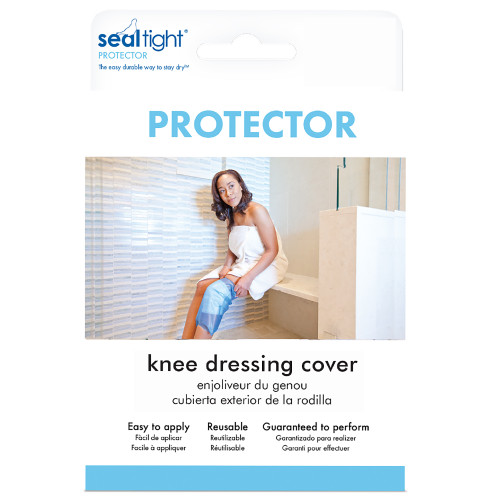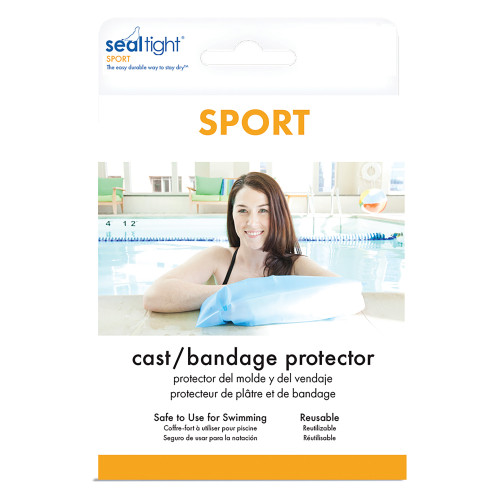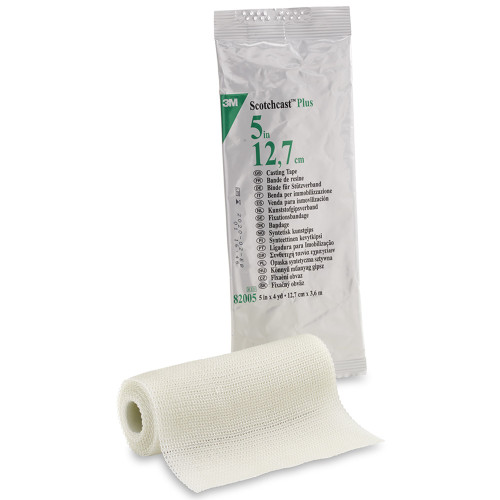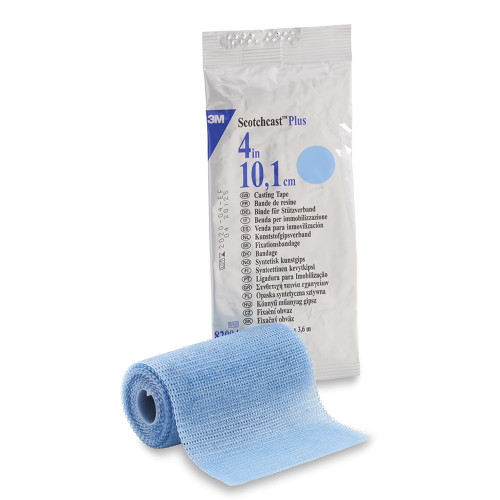-

Seal-Tight
Seal-Tight Cast Cover 28 Inch Leg Length Thermoplastic Elastomer Blue
Seal-Tight is a safe, economical protector for casts and bandages during recreational water activities or daily showering and bathing.Easy application eliminates the need for pumps, Velcro straps and adhesive tapes that may irritate skin With normal...
$32.39 -

Seal-Tight
Seal-Tight Knee Cast and Bandage Protector Thermoplastic Elastomer Blue
The easy, durable way to keep bandages and casts dry. Recommended by doctors for showering and bathing, Seal-Tight Original cast and bandage protector is the best watertight protection available. Easy to apply application ring eliminates need for...
$30.79 -

Seal-Tight
Seal-Tight Arm Cast Cover Thermoplastic Elastomer Blue
Seal-Tight is a safe, economical protector for casts and bandages during recreational water activities or daily showering and bathing.Easy application eliminates the need for pumps, Velcro straps and adhesive tapes that may irritate skin With normal...
$32.39 -

Performance Splinting
Performance Splinting Unpadded Precut Splint 4 X 38 Inch Fiberglass White
Package Count: 10. A unpadded fiverglass pre-cut splint that serves as reinforcing strips, pre-cut splints, and as a vital component in the creastion of a Total Contact Cast When used as a traditional fiberglass splint, the clinician needs to use a...
$99.99 -

3M
3M Scotchcast Plus Cast Tape, White, 1 in x 72 in
A lightweight, strong and durable casting tape that combines the benefits of a fiberglass casting tape with the handling ease of plaster.Water-activated resin lets you control working time according to application needs High and early strength allows for...
As low as $12.22 -

3M
3M Scotchcast Plus Cast Tape, White, 5 in x 12 ft
3M Scotchcast Plus is a lightweight, strong and durable casting tape that combines the benefits of a fiberglass casting tape with the handling ease of plaster.Water-activated resin lets you control working time according to application needs High and...
As low as $15.57 -

3M
3M Scotchcast Plus Pink Cast Tape, Water-Activated Resin 2 in x 12 ft
3M Scotchcast Plus is a lightweight, strong and durable casting tape that combines the benefits of a fiberglass casting tape with the handling ease of plaster.Water-activated resin lets you control working time according to application needs High and...
As low as $9.52 -

3M
3M Scotchcast Plus Cast Purple Tape, Water-Activated Resin, 3 in x 12 ft
3M Scotchcast Plus is a lightweight, strong and durable casting tape that combines the benefits of a fiberglass casting tape with the handling ease of plaster.Water-activated resin lets you control working time according to application needs High and...
As low as $14.55 -

BSN Jobst
Specialist Plaster Splint Plaster of Paris White, 5-8 Minute Set Time
Specialist plaster of Paris uses a time-tested formula and manufacturing process that produces a consistent plaster that is uniformly coated and adhered to the gauze. This formula offers minimal plaster loss to ensure maximum strength and a smooth cast...
As low as $47.59 -

3M
3M Scotchcast Plus Cast Tape, Water-Activated Resin, 4 in x 12 ft
A lightweight, strong and durable casting tape that combines the benefits of a fiberglass casting tape with the handling ease of plaster.Water-activated resin lets you control working time according to application needs High and early strength allows for...
As low as $14.35 -

3M
3M Scotchcast Quick Step Double Sided Felt Padded Precut Splint 3 X 35 Inch White
Package Count: 10. 3M's Scotchcast Quick Step double sided felt splint is for use in the construction of common orthopedic splints. Breathable felt on both sides helps eliminate the risk of wrong side application. No more guessing which side is right,...
$159.75 -

TCC-EZ
TCC-EZ 3 Inch Total Contact Cast System Single Kit without Boot 3 Inch White
TCC-EZ is a novel total contact casting system that replaces several rolls with one simple, easy to apply casting component. With an open weave, this fiberglass component can be applied in under 5 minutes, significantly reducing the time required to...
$234.48
Splint & Cast Bandages

Splint and Cast Supplies
Cast vs. Splint
Unsure about the difference between a cast and splint?
A cast surrounds an injury, like a broken bone or sprain, to support and immobilize it as it heals. Casts consist of fiberglass or plaster, and application and removal are done in a doctor’s office.
A splint, on the other hand, is used more often on fractures, tendon injuries, and other soft-tissue injuries. Instead of surrounding the injured area like a cast, the splint supports the joint or injury on one side. It is usually more temporary than a cast. Some splints and splint materials are available over the counter, such as finger splints or arm slings.
Cast and Splint Materials
There are a variety of cast and splint materials to choose from. Fiberglass casts are light, breathe well, and are more desirable if the injured area needs to be X-rayed during the healing process. The material is more malleable, so it's better for awkward angles, too. Plaster takes longer to dry and set, whereas fiberglass sets pretty quickly.
Splints can also be made of fiberglass, or, in the case of finger splints, thin, pliable metal. They can also be made of fabric, like arm slings.
Both fiberglass and plaster casting materials should be kept dry. A wet plaster cast can dissolve, irritate the skin underneath, and in the worst cases, even break. A fiberglass cast or splint is technically waterproof, but the padding underneath is not, so it is best to keep them dry as well. Shower rather than taking baths, and wear a protective plastic sleeve or bag to protect the wounded area.
Cast Padding
Before applying a cast, cast padding is often used to cover the skin. Made of polyester or cotton, padding is often doubled up to pad sensitive areas like joint and bone protrusions such as wrists, ankles, and elbows to prevent rubbing and irritation once the cast has been applied.
In the case of an open wound or compromised skin under the cast surface, sterile cast padding is used. Non-sterile cast padding works well for standard casting applications. Cast padding is available in multiple sized packages, depending on whether you will need to apply a single cast or use it for several instances of casting.
Casting Tape and Plaster Bandages
Fiberglass casting tape actually makes up a fiberglass cast and comes in a variety of colors. At least two layers of fiberglass tape are needed to form a cast, so choose how much casting tape you need by the size and area the cast will cover. Not only is fiberglass lighter, more durable, and breathable than plaster, X-rays of the area are also possible without removing the cast.
Plaster cast bandages are heavier and denser than fiberglass. They are extremely durable and cheaper, and are often used for leg and arm casts that need to stay on for a longer period of time before being removed.
Splint Roll Fiberglass
Splint roll fiberglass shares characteristics with fiberglass casting tape, but it is designed for creating splints rather than casts. It generally incorporates some padding, is reversible, and requires only a small amount of water to activate the hardening process.
Never apply a cast without the direct supervision and direction of a medical professional. While temporary splints can be applied in a field situation, more permanent support should be applied by a medical or training professional as soon as possible following the injury.
Be sure to watch the area for swelling, report any numbness or lack of sensation, coldness, or discoloration. Never use any object to scratch under the cast. It can affect the integrity of the skin and even cause serious infection, and compromise healing.
Cast vs. Splint
Unsure about the difference between a cast and splint?
A cast surrounds an injury, like a broken bone or sprain, to support and immobilize it as it heals. Casts consist of fiberglass or plaster, and application and removal are done in a doctor’s office.
A splint, on the other hand, is used more often on fractures, tendon injuries, and other soft-tissue injuries. Instead of surrounding the injured area like a cast, the splint supports the joint or injury on one side. It is usually more temporary than a cast. Some splints and splint materials are available over the counter, such as finger splints or arm slings.
Cast and Splint Materials
There are a variety of cast and splint materials to choose from. Fiberglass casts are light, breathe well, and are more desirable if the injured area needs to be X-rayed during the healing process. The material is more malleable, so it's better for awkward angles, too. Plaster takes longer to dry and set, whereas fiberglass sets pretty quickly.
Splints can also be made of fiberglass, or, in the case of finger splints, thin, pliable metal. They can also be made of fabric, like arm slings.
Both fiberglass and plaster casting materials should be kept dry. A wet plaster cast can dissolve, irritate the skin underneath, and in the worst cases, even break. A fiberglass cast or splint is technically waterproof, but the padding underneath is not, so it is best to keep them dry as well. Shower rather than taking baths, and wear a protective plastic sleeve or bag to protect the wounded area.
Cast Padding
Before applying a cast, cast padding is often used to cover the skin. Made of polyester or cotton, padding is often doubled up to pad sensitive areas like joint and bone protrusions such as wrists, ankles, and elbows to prevent rubbing and irritation once the cast has been applied.
In the case of an open wound or compromised skin under the cast surface, sterile cast padding is used. Non-sterile cast padding works well for standard casting applications. Cast padding is available in multiple sized packages, depending on whether you will need to apply a single cast or use it for several instances of casting.
Casting Tape and Plaster Bandages
Fiberglass casting tape actually makes up a fiberglass cast and comes in a variety of colors. At least two layers of fiberglass tape are needed to form a cast, so choose how much casting tape you need by the size and area the cast will cover. Not only is fiberglass lighter, more durable, and breathable than plaster, X-rays of the area are also possible without removing the cast.
Plaster cast bandages are heavier and denser than fiberglass. They are extremely durable and cheaper, and are often used for leg and arm casts that need to stay on for a longer period of time before being removed.
Splint Roll Fiberglass
Splint roll fiberglass shares characteristics with fiberglass casting tape, but it is designed for creating splints rather than casts. It generally incorporates some padding, is reversible, and requires only a small amount of water to activate the hardening process.
Never apply a cast without the direct supervision and direction of a medical professional. While temporary splints can be applied in a field situation, more permanent support should be applied by a medical or training professional as soon as possible following the injury.
Be sure to watch the area for swelling, report any numbness or lack of sensation, coldness, or discoloration. Never use any object to scratch under the cast. It can affect the integrity of the skin and even cause serious infection, and compromise healing.
